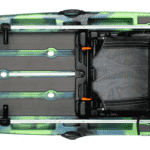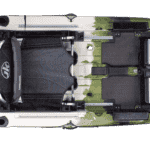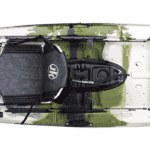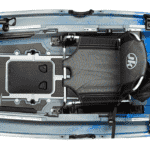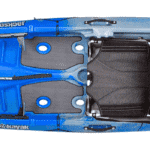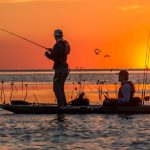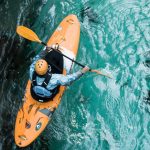Jackson YuPIK is all about customizability. With an open-concept deck and tons of gear tracks all over, this kayak is a blank slate waiting for you to make it yours.

Kayak in a box? How cool is that! As portable as an inflatable but exponentially sturdier and more versatile, it’s an excellent option for anyone who wants a hassle-free, minimal-storage solution for kayaking anywhere, anytime.
Description
ORU Bay ST is a true masterpiece of design and craftsmanship, a seaworthy, highly versatile kayak that folds down into a box you can carry around on public transport or fit into the back of any sedan or SUV. Though far from budget-friendly, it’s an excellent investment for any paddlers who want a tough-as-nails kayak they can travel around the country/world.
I was lucky enough to test the ORU Bay ST personally, and I’m delighted to say it’s a kayak that more than lives up to its claims. Let’s dive into the positives and negatives of this one-of-a-kind kayak so you can decide if it’s worth the investment.
Size and Weight
This is the real selling point of any ORU kayak!
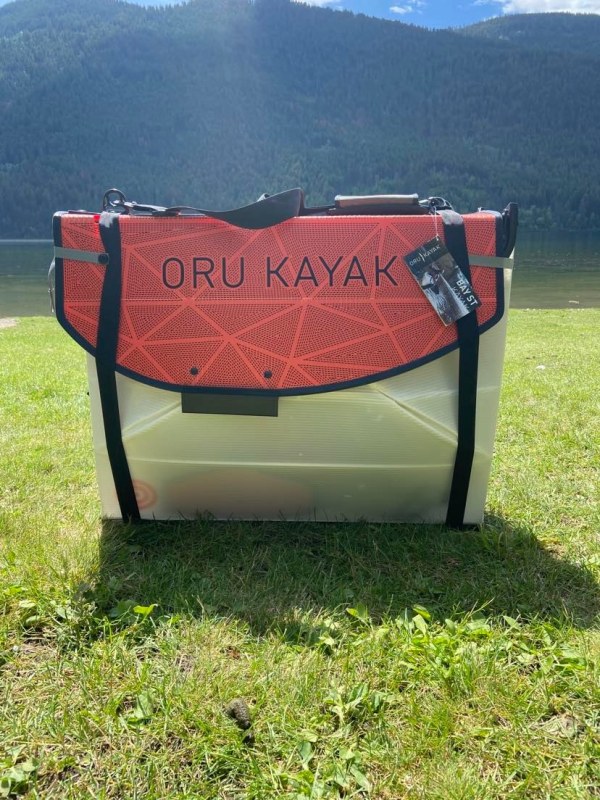
When folded down into the box, it’s 33″ x 14″ x 29″. I transported it in both the back seat and trunk of my Toyota Corolla (a small sedan) and it fit with no problem at all. No need for roof racks or kayak cradles; just sling the box into the back of your vehicle and hit the road.
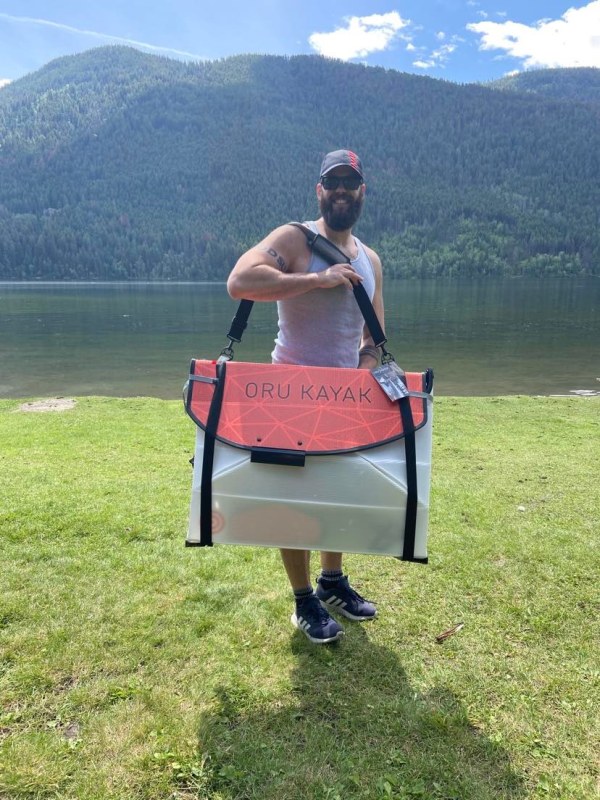
It’s small and light enough you can carry it around like a bag (a 26-pound bag, to be precise), and the shoulder straps that are used to secure it in its folded configuration make it easy to haul it around one-handed.
However, once it’s assembled (I’ll give more details on the process below), it’s a 12-footer (12’ 3”, more accurately) that’s 25 inches wide with a 16″ x 30″ cockpit. Add to that 90L of storage space, and you’ve got a pretty decent-sized kayak.
But still a very light kayak! Here’s proof:
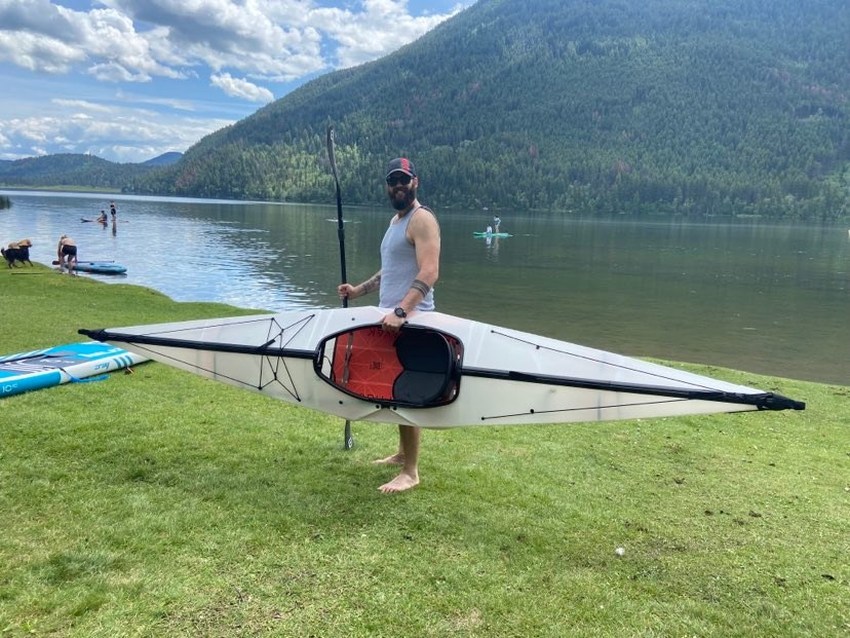
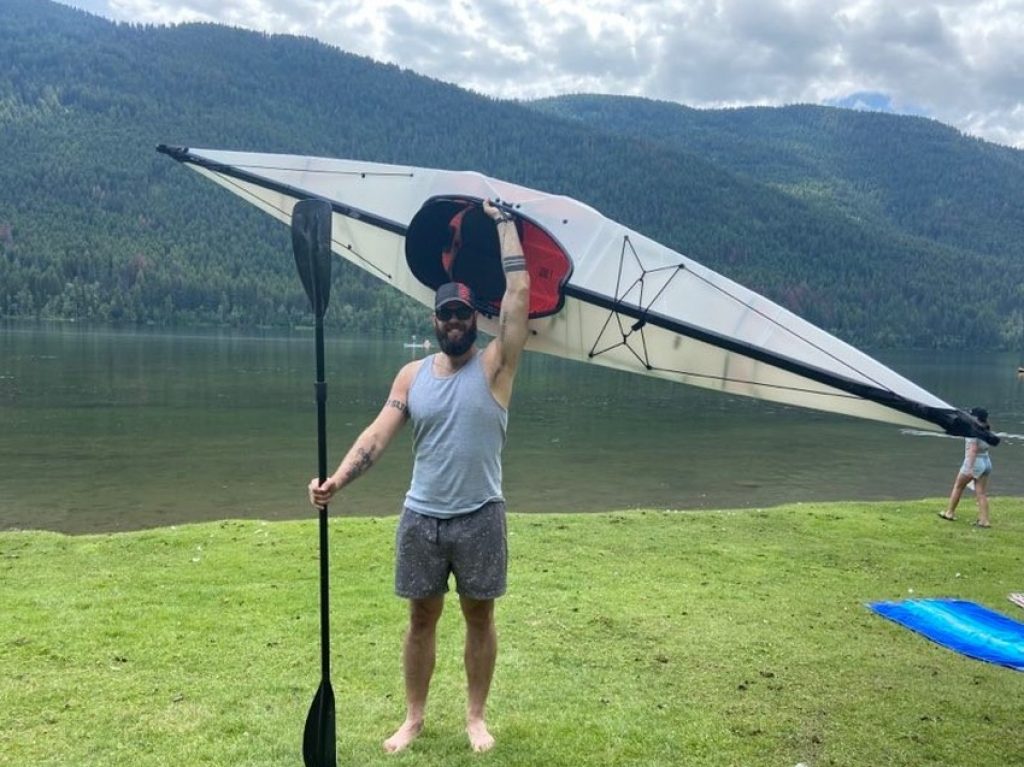
26 pounds is no more than I’d lift at the gym, and I had absolutely no problem carrying this kayak to and from the water. If I was ever in a situation where I had to hike up to a lake/river, this is definitely the kayak I’d want to take.
Materials
You may be thinking, “Well, if it’s so lightweight, surely it can’t be sturdy.” Au contraire, mon ami!
The kayak is made from a 5 mm-thick, double layered, custom extruded polypropylene (a tougher version of the plastic used to make regular hard-shell kayaks). Not only has it been treated with a special UV-resistant coating that protects it against sunlight for 10 years, but it’s rated (according to the manufacturer) for 20,000 folds.
Its origami-like design (which you’ll see more about below) comes with the folds already integrated, and they’ve clearly been reinforced to add durability. Though it was incredibly light, once it was assembled and I had it out on the water, it felt as sturdy and damage-resistant as any thermoplastic/rotomolded kayak I’ve tried.
Will it handle hard impacts with rocks, submerged trees, or underwater obstacles? Yes it will, though perhaps not as well as kayaks with a thicker hull. I wouldn’t rate it quite as tough as some of the sturdier hard-shell kayaks I’ve tried, but it’ll definitely outlast even the best inflatable kayaks (and many of the lower-end hard-shells, too).
One concern many people have with a kayak like this is waterproofing. You’d think that with all the cracks, crannies, and holes, water would seep in. Not so! The combination of foam plugs and neoprene end caps ensure that both the tips are fully waterproof, and the marine-grade aluminum zipper channels close the top of the kayak beautifully tight. The water that got into the kayak were what dripped off my feet when I first stepped into it.
(Note: It’s also compatible with most universal spray skirts, adding an extra layer of protection against water.)
Assembly/Disassembly
I’m a sucker for a puzzle, and that’s exactly what I got with the ORU Bay ST. It’s definitely not as “plug and play” as inflatable kayaks (to which you just add air and presto!) and more time-consuming than your standard kayak (which comes pre-assembled). But honestly, I had a blast with it!
As you’ll see in the demo video, the process isn’t too complex:
The box the kayak came in also included a paper manual (which I definitely preferred!) that illustrated in easy-to-read color images how to assemble the kayak.
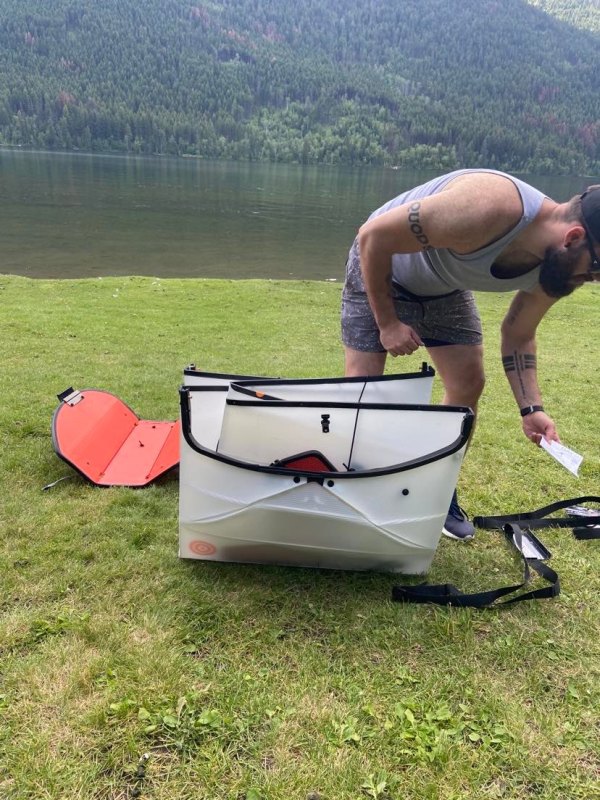
The first time I set to assembling it, it took my wife and I working together about 25 minutes to decipher the manual and follow the step-by-step instructions. (Me being as large as I am, I’m always wary of anything I can break, so I tend to take my time and be really careful.)
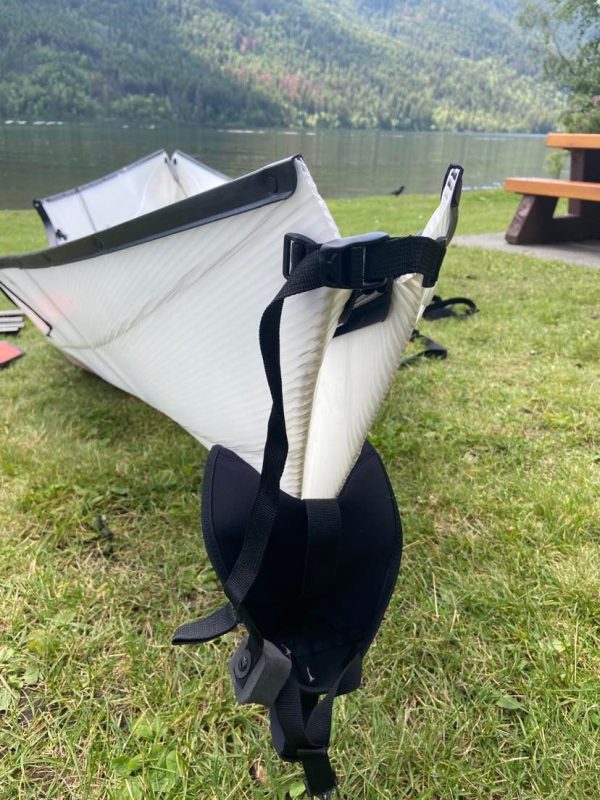
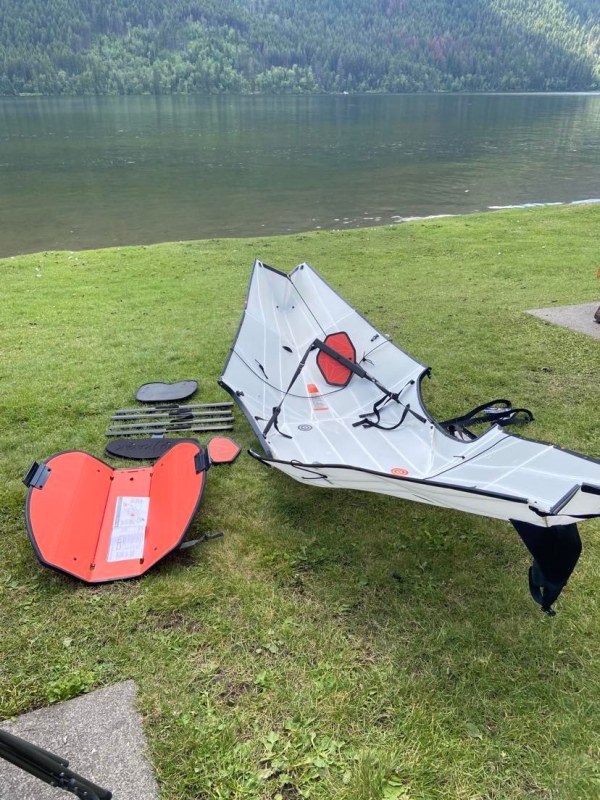
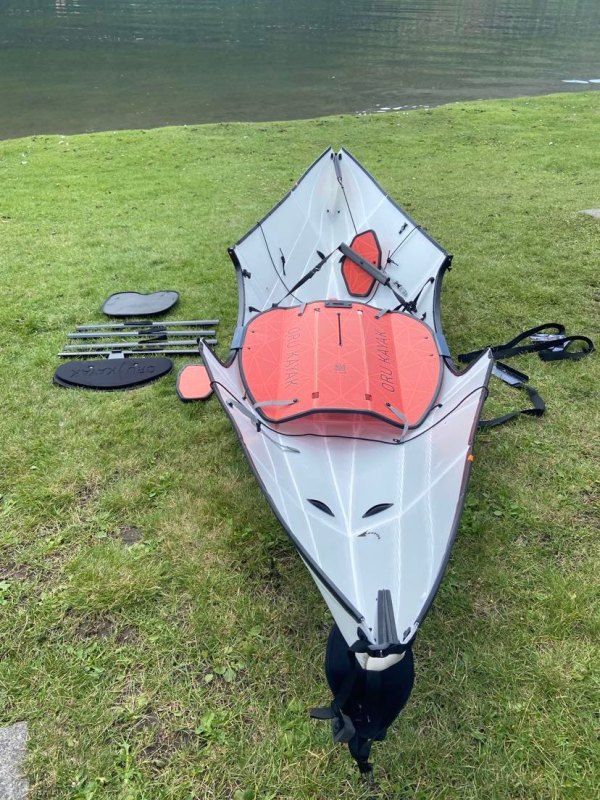
The process wasn’t difficult, though there were a few times that we spent extra minutes puzzling over a specific detail to make 100% sure we got it right. Combining the instruction video (linked above) and the paper manual would definitely have made the process easier, but most rivers/lakes/national parks in British Columbia are a wireless-free zone, so we had only the physical manual on hand.
But following the step-by-step instructions, we got the kayak assembled, all the pieces put in place, and ready to head out on the water. I was impressed by how sturdy it felt once it was assembled, and I can say with a fair degree of confidence that it will definitely last for years of regular use.
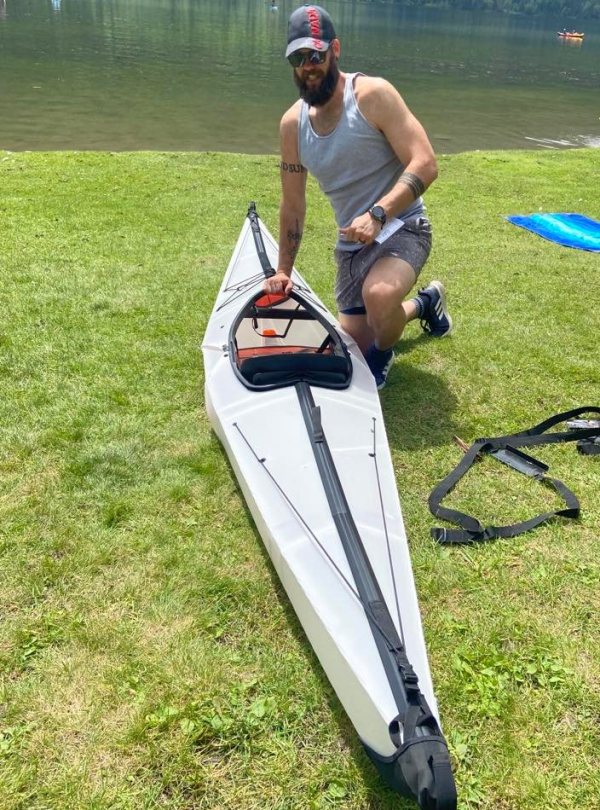
After paddling, disassembly was an absolute breeze. I had it taken apart into individual components in under 5 minutes. Once it had dried, it took another 5 minutes to put all the pieces together and re-fold it back into its original box shape. Not bad at all!
Take note: assembly gets much easier with practice. On my second attempt, I had it all put together in under 10 minutes, and disassembly took under 5 minutes. Once you figure out how the origami folding design works and how everything goes together, it’s a breeze.
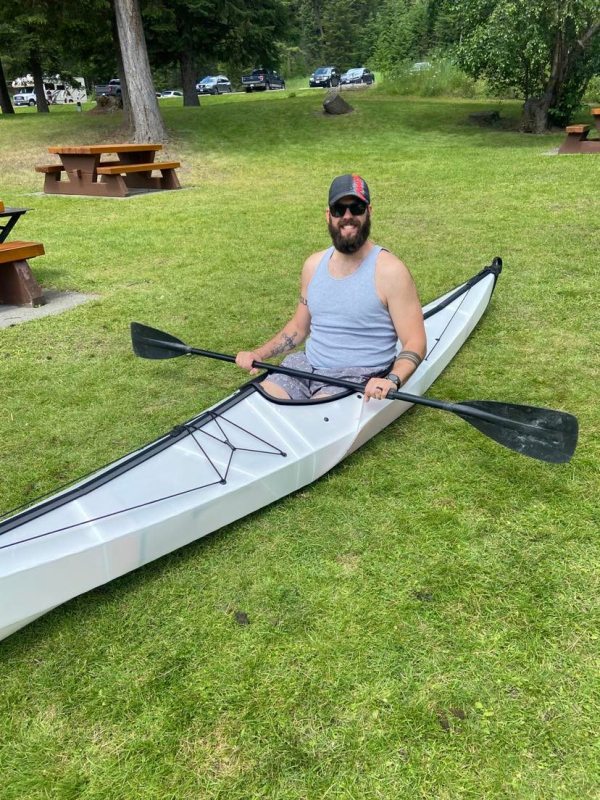
Features
There aren’t a lot of features on this kayak. In addition to the various straps and bungee cords that tighten and support the frame, it includes a footboard (adjusted via straps), a comfortable (if thin) padded seat, adjustable backrest, and the aforementioned 90L of storage space. Simple and straightforward, right?
One downside is that the storage space is somewhat inaccessible. You have to put your gear into the compartment behind the seat before you lock the seat in place and finish assembling the rear of the kayak. Once it’s all put together, it’s going to be tough to get at any large/bulky items you’ve stored without half-disassembling the kayak.
Comfort
Comfort was a bit of an issue for me. At 6’6”, I found the cockpit was roomy enough once I was inside, but getting inside was a challenge, to say the least.
This is how tight the aperture was for my over-sized frame:

Basically, to slide into the cockpit, I had to lift myself up and half-sit on the back of the kayak so my knees would fit through the opening. It left me a bit uneasy about how difficult I would find it to bail out should I capsize.
The seat back, too, was a bit low for me. It offered only minimal lumbar support, so it would definitely be harder on my lower back over an hours-long paddling session.
However, the ORU Bay ST website says that it’s sized for a Max Paddler Height of 6’ 3”, which means I’m larger than the target user. My 6’2” brother-in-law found it was the perfect size for him. He had no trouble getting in and out of the cockpit, and the seat height suited him perfectly.
(Note: After checking out the ORU website, I found the Beach ST is better-suited to paddlers of my height.)
However, with the weight capacity of 300 lbs., I found it could more than handle my weight (250 lbs) plus the weight of my PFD, paddle, and the gear I brought along for the trip.
Performance
The ORU website says the Bay ST is designed to be “versatile, fast, and sporty”, and after taking it out for a few paddles, I can absolutely agree!
Thanks to its light weight, it was incredibly easy to handle, and I found I could make incredibly sharp turns with far less effort than even a lightweight Pelican 10-footer.

It’s also insanely speedy. Both my brother-in-law and I took it for a spin to test its speed, and I’d rate it around 20% faster than the heavier hard-shell kayaks we’re accustomed to.
The kayak is designed for zipping around bays and paddling in the sea/ocean, so it’s built with very high secondary stability. I had no trouble navigating the swells and troughs of the ocean off the Vancouver coast, and it stayed beautifully balanced even when the surf grew choppy.
But the high secondary stability does mean it has lower primary stability. When I took it out on a calm lake, it felt very tippy and I got quite the abs workout trying to keep it steady as I paddled.
Warranty
For the price, I expected more than a 1-year warranty. Given its sturdiness, I can’t see it having any issues within the first 3-4 years (save for factory defects), so I’d prefer a warranty that lasted 5+ years so I could get repairs/replacement parts if needed.
However, I did love the 30-Day “Love Your Boat” Guarantee. This allows you to return your boat for a full refund if you don’t love it at the end of 30 days. I can say in all honesty that I doubt many people will ever take advantage of that guarantee because of how excellent the kayaks are, both in terms of design/durability and performance.
Closing Thoughts
I loved the ORU Bay ST more than I thought I would! Aside from the few minor quibbles, it was a user-friendly, easily assembled, surprisingly sturdy, delightfully lightweight and portable kayak that I have no trouble envisioning myself using for years to come. The fact that I can store it in any corner of my garage and throw it into the back of my sedan/SUV to take it anywhere without the need for roof racks makes it an absolute win.

